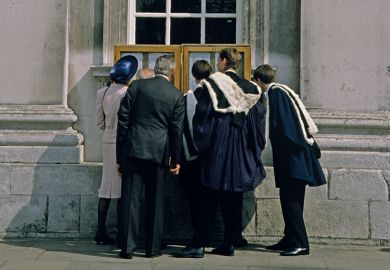Concerns that grade inflation has taken hold in English higher education have been stoked by new data that reveal that a greater share of students now get top degrees compared with undergraduates who enrolled with the same A-level scores in the past.
A comparison of degree classification data between 2013-14 and 2016-17 in a report from the Higher Education Funding Council for England shows that the proportion of graduates leaving with a first or a 2:1 stayed the same only for those with the very highest grades.
The share receiving top marks rose for other grade profiles, with the increase being sharpest for those entering higher education with the poorest A levels: the share of students getting a first or a 2:1 climbed by almost 10 percentage points among those with grades of CCD or below at A level.
For firsts, there was an increase in the share obtaining the mark at every entry grade profile, with the largest being among students entering university with BCC: 27 per cent of these students received a first in 2016-17, compared with 18 per cent in 2013-14.
The findings are likely to fuel concerns about grade inflation at UK universities, fears that have been increasing in light of year-on-year increases in the proportion of students getting top marks, particularly firsts. The latest figures for 2016-17 showed that more than a quarter of first-degree students got a first.
One reason often put forward by some universities for the rising share of firsts and 2:1s is that students are starting their courses with higher grades and so are better equipped to achieve a good class of degree. However, the data in the Hefce report throw considerable doubt on this explanation.
Bernard Rivers, a former visiting fellow at the University of Cambridge who has analysed the rise over several decades in top grades awarded at the institution, said that although it was still “theoretically conceivable” that students with similar grades worked harder or received better teaching between 2013 and 2016, he was not convinced by such an explanation.
“What on earth could cause such a significant increase in talent or diligence? No. This is grade inflation, without a doubt,” he told Times Higher Education.
The data, published in one of Hefce’s final reports before it was replaced by the Office for Students on 1 April, are likely to cement the issue as one of the top priorities for the new regulator. In his initial guidance to the OfS, Sam Gyimah, the universities minister, singled it out, saying that “unchecked grade inflation risks damaging the reputation of the entire HE sector” and urging the body “to challenge this wherever it occurs”.
Nick Hillman, director of the Higher Education Policy Institute, said that there needed to be a “collective” effort to tackle the problem, something that he said many senior leaders inside universities understood.
“It does need to be collective and overseen from above to have an impact because the incentives and temptation to award more top degree classifications are strong in the competitive higher education system that we now have,” he said.
Meanwhile, the Hefce report also provides further evidence to suggest that, once entry grades are accounted for, students from disadvantaged backgrounds can often outperform their peers from more advantaged areas.
For example, among students who entered university with A-level grades between A*A*A and BBC, those from the most advantaged neighbourhoods were the least likely to get a first. At most top grade levels, students from more disadvantaged areas had a higher share of firsts.
Comparing students with similar A-level entry grades in the study also provides interesting findings on degree outcomes by ethnic background, gender, age and disability.
For example, the gap between the share of white and black students receiving a first or a 2:1 – which overall is 22 percentage points – is bigger (up to 26 percentage points) for those entering university with A-level grades of CCC or below or those holding BTECs.
For gender, the data show that the overall gap between the share of male and female students getting a first or a 2:1 of five percentage points is narrower for students with the very highest and lowest A-level grades. And the gender gap is virtually non-existent for students entering university with BTECs or the International Baccalaureate.
Find out more about THE DataPoints
THE DataPoints is designed with the forward-looking and growth-minded institution in view
POSTSCRIPT:
Print headline: As the lowest rise, so too do fears of grade inflation
Register to continue
Why register?
- Registration is free and only takes a moment
- Once registered, you can read 3 articles a month
- Sign up for our newsletter
Subscribe
Or subscribe for unlimited access to:
- Unlimited access to news, views, insights & reviews
- Digital editions
- Digital access to THE’s university and college rankings analysis
Already registered or a current subscriber?




